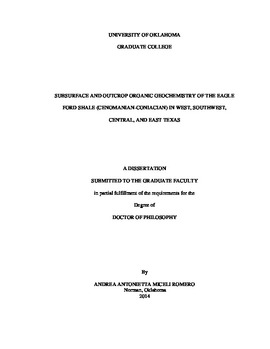| dc.description.abstract | A comprehensive organic geochemical analysis was performed to a suite of outcrops and core samples from the Eagle Ford Shale Group from West, Southwest, Central and East Texas with the aim of determining variations in organic matter source, thermal maturity and depositional environments. Oils and condensates produced from Eagle Ford Shale and San Miguel reservoirs were analyzed to determine the origin of these liquids. A total of 180 samples were subjected to total organic carbon (TOC) and Rock Eval analysis for geochemical screening, and one sample from each location was analyzed for vitrinite reflectance (%Ro). Rock samples with good source rock potential (TOC>1.0% wt.) were selected for biomarker and isotope analyses. These analyses were carried out by means of gas chromatography (GC), gas chromatography-mass spectrometry (GC-MS), and gas chromatography-isotope ratio mass spectrometry (GC-IRMS).
TOC and Rock Eval parameters show that the Eagle Ford Shale has excellent source rock potential and is dominated by Type II kerogen indicating a marine origin. Distributions of regular steranes, hopanes and monoaromatic steroids (MAS) point towards a marine carbonate depositional environment. Aryl isoprenoids suggest the occurrence of intermittent photic zone anoxia (PZA). In addition n-alkanes, steranes distribution, and the tentative identification of gammacerane suggest deposition under hypersaline conditions in West and East Texas. Biomarker parameters indicate that in East Texas the Eagle Ford Shale was partly sourced by terrigenous organic matter, reflecting the influence of the Harris Delta. Thermal maturity parameters indicate that the Eagle Ford Shale is immature to marginally mature in West and Central Texas, and show a progressive increase in maturity increase towards the southeast following the regional dip. In East Texas, the Eagle Ford Shale is in the main stage of oil generation.
Geochemical logs show a minimal range of vertical variation within the Eagle Ford Shale Group. The Lower Eagle Ford Shale Formation has the highest TOC and hydrogen index (HI) values and in particular, the Lozier Canyon Member is the most organic-rich. Pristane and phytane (Pr/Ph) and biomarker ratios suggest the establishment of stronger anoxic conditions during deposition of the Lower Eagle Ford Shale Formation compared to the Upper Eagle Ford Shale, where the latter may have received an additional siliciclastic and terrigenous organic matter input. In East Texas, Pr/Ph ratios indicate deposition under oxic-suboxic conditions for the entire Eagle Ford Shale interval analyzed. Isotope data indicates a marine organic matter source for the Eagle Ford Shale Group, but δ13C values do not show significant organic facies, depositional environment, or thermal maturity changes.
Geochemical data were correlated with an already established sequence stratigraphic framework for the Eagle Ford Shale Group in order to identify relationships between organic geochemical trends and stratigraphic sequences. In this study, these observations reached a general interpretation and it is recommended they be further refined by high-resolution organic geochemistry studies. | en_US |
